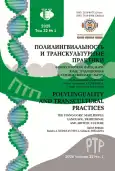Semantic Opposition Osho - Sheme ‘White - Black’ in the Paremiological Fund of the Mari Language
- Authors: Mitruskova A.A.1
-
Affiliations:
- Mari State University
- Issue: Vol 22, No 1 (2025): THE FINNO-UGRIC MARI PEOPLE: LANGUAGE, TRADITIONAL AND ARTISTIC CULTURE
- Pages: 77-87
- Section: LINGUOCULTURE
- URL: https://journal-vniispk.ru/2618-897X/article/view/326872
- DOI: https://doi.org/10.22363/2618-897X-2025-22-1-77-87
- EDN: https://elibrary.ru/FVMKUN
- ID: 326872
Cite item
Full Text
Abstract
In this study an analyze the paroemias with the lexemes osh / osho ‘white’ and shem / sheme ‘black̕, including as part of semantic oppositions is performed. The research was carried out on the material of the national corpus of the Mari language, as well as materials from dictionaries, collections of folklore. The work describes the semantic content of the paroemias, provides a decoding of some cultural codes, and describes the value system of the Mari people. In the structure of the opposition to osho - sheme , in addition to the lexical semantics proper, evaluative semantics is actualized: osho ‘white’ embodies light, pure, real, true, sheme ‘black’ contains axiological components of the meaning ‘dark, evil, bad, joyless, heavy, harmful, oppressive’. The semantic opposition under consideration reflects the idea of unity of opposite principles: Osho pelen kech-kunamat sheme liesh ‘There is always black next to white.’ The opposition is interpreted ambiguously in the national consciousness: Sheme da sheremet, osho da keremet ‘Black but dear (cute), white but damn’, Shem shorykat osh pacham yshten kertesh ‘Even a black sheep can produce a white lamb’. The semantic opposition osho - sheme ‘white - black’ to a certain extent embodies the people’s worldview and perception, the assessment of reality.
Keywords
About the authors
Anzhelika A. Mitruskova
Mari State University
Author for correspondence.
Email: angel-ika.30@mail.ru
ORCID iD: 0009-0007-5805-5214
postgraduate student of the Department of Finno-Ugric and Comparative Philology
1 Lenin Sq, Yoshkar-Ola, 424000, Russian FederationReferences
- Kitikov, A.E. 1981. Proverbs. Yoshkar-Ola: Mari Book Publishing House. Print. (In Mari)
- Kitikov, A.E. 1991. Dictionary of Mari proverbs and sayings. Yoshkar-Ola: Mari Book Publishing House. Print. (In Mari)
- Kitikov, A.E., eds. 2004. Collection of Mari folklore: Proverbs and sayings. Yoshkar-Ola: MarSRILLH publ. Print. (In Russ.) (In Mari)
- Evseev, T.E. 1994. Mari folklore: Mari legends, fairy tales, predictions, dreams, moral teachings, humor, riddles, prayers and spells. Yoshkar-Ola: Mari Book Publishing House. Print. (In Mari)
- Gracheva, F.T. 2001. Hill Mari proverbs, sayings, riddles, signs. Yoshkar-Ola: Mari State University. Print. (In Russ.) (In Mari)
- Abukaeva, L.A. 2018. Prohibitions in the system of Mari's views: monograph. Yoshkar-Ola: Mari State University. EDN: YROWAZ Print. (In Russ.)
- Semenenko, N.N. 2011. Russian paroemias: functions, semantics, pragmatics. Belgorod: Belgorod University publ. EDN: QWUNSP Print. (In Russ.)
- Lomakina, O.V. 2018. Phraseology in the text: functioning and idiostyle: monograph. Edited by V.M. Mokienko. Moscow: RUDN publ. EDN: ZAXLUD Print. (In Russ.)
- Cherkasskij, M.A. 1978. “The experience of building a functional model of one particular semiotic system (proverbs and aphorisms).” In Paremiological collection. Proverb. Riddle (structure, meaning, text), pp. 35–52. Moscow: The science. Print. (In Russ.)
- Matveeva, G.G., and M.A. Seregina. 2009. “To the definition of the concept of “paroemia” (based on the material of the Russian and German languages).” Pyatigorsk State University bulletin, no. 3, pp. 175–178. EDN: KZPRTX Print. (In Russ.)
- Seliverstova, E.I. 2009. “About some constants in the paremics.” Vestnik of Novgorod State University, no. 54, pp. 66–70. EDN: KZUNCJ Print. (In Russ.)
- Kovshova, M.L. 2019. Linguocultural analysis of idioms, riddles, proverbs and sayings. Anthroponymic code of culture: monograph. Moscow: Lenand publ. EDN: BKRGSM Print. (In Russ.)
- Bredis, M.A., Dimoglo, M.S., and O.V. Lomakina. 2020. “Paremias in Modern Linguistics: Approaches to Study, Text-Forming and Linguocultural Potential.” RUDN Journal of Language Studies, Semiotics and Semantics, vol. 11, no. 2, pp. 265–284. https://doi.org/10.22363/2313-2299-2020-11-2-265-284 EDN: JKHVJH Print. (In Russ.)
- Zakharova, L.B., and E.V. Zakharova 2021. “Definition and Classification of Paroemia in the Russian and Spanish Languages.” Philology. Theory and Practice, vol. 14, no. 11, pp. 3560–564. https://doi.org/10.30853/phil20210577 EDN: LEEJOP Print. (In Russ.)
- Bakumenko, O.N. 2005. “Correlation of multilingual color concepts in V. Nabokov’s bilingual idiolect.” In Problems of ethnolinguistics and ethnopedagogy in the context of regional studies: proceedings of the All-Russian Scientific Conference. Slavyansk-on-Kuban: Publishing Center of the Slavic State Pedagogical Institute, pp. 134–147. Print. (In Russ.)
- Dictionary of the Mari language. 1998. Edited by I.S. Galkin, vol. IV. M ‒ Ő (ma ‒ őrchyktarymash). Print. (In Russ.) (In Mari)
- Dictionary of the Mari language. 2004. Vol. IX. Sh, Shh. Print. (In Russ.) (In Mari)
- Kitikov, A.E., eds. 2006. Collection of Mari folklore: Mari folk riddles. Yoshkar-Ola: MarSRILLH publ. Print. (In Russ.) (In Mari)
Supplementary files









